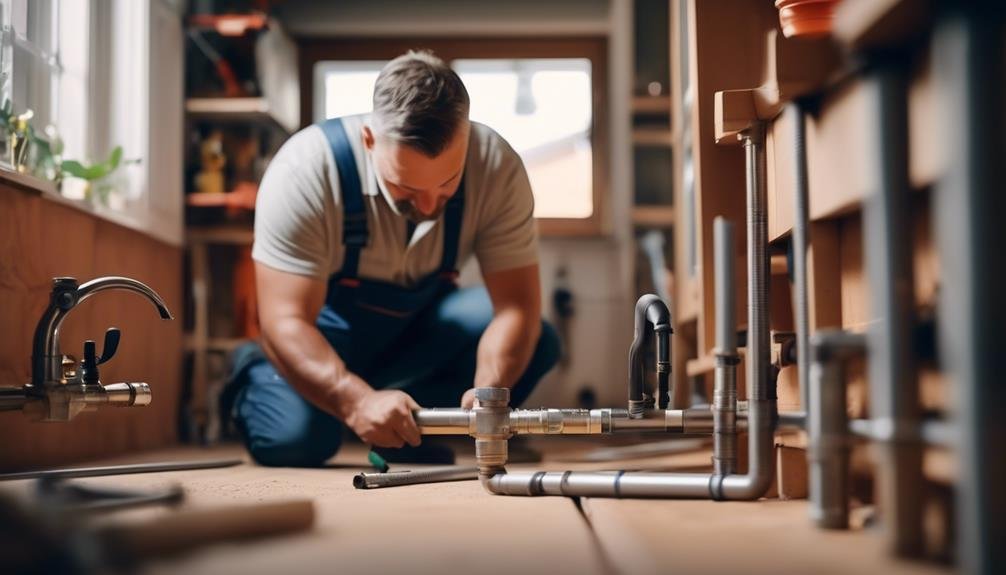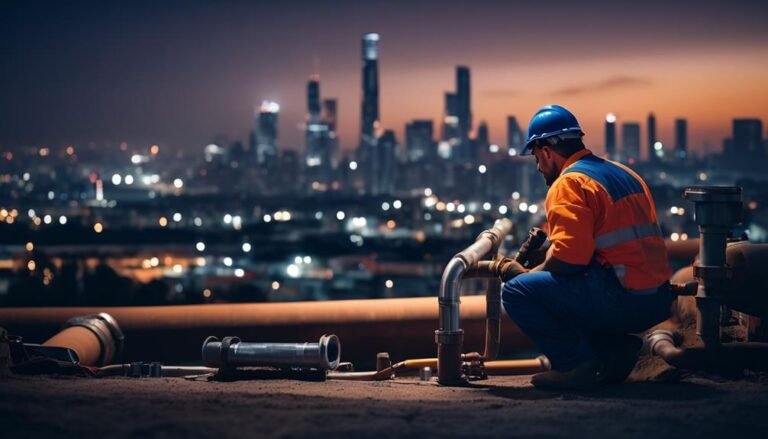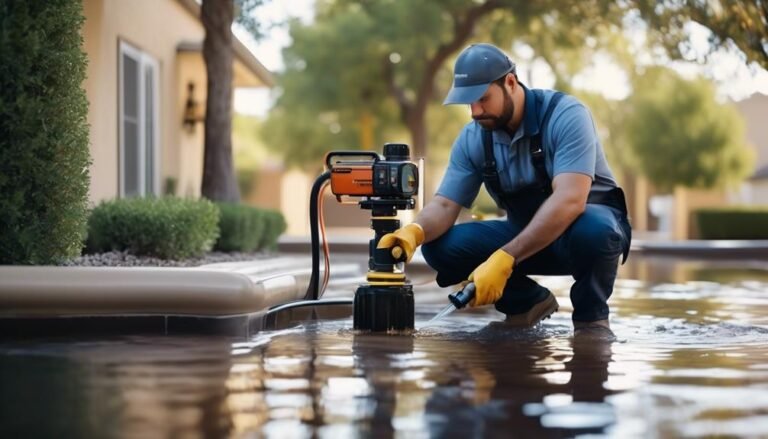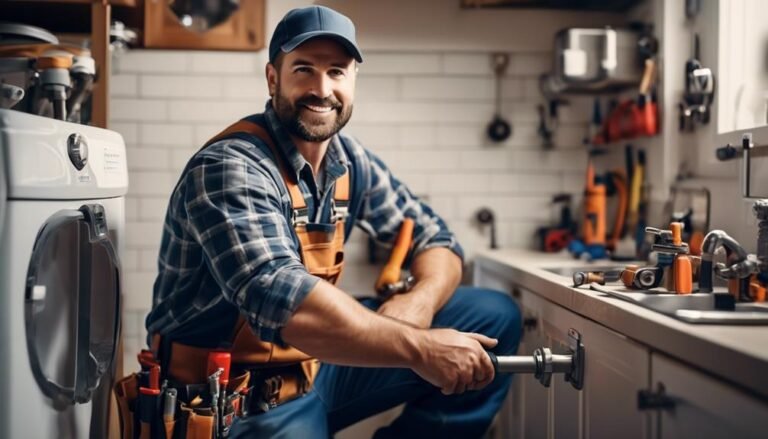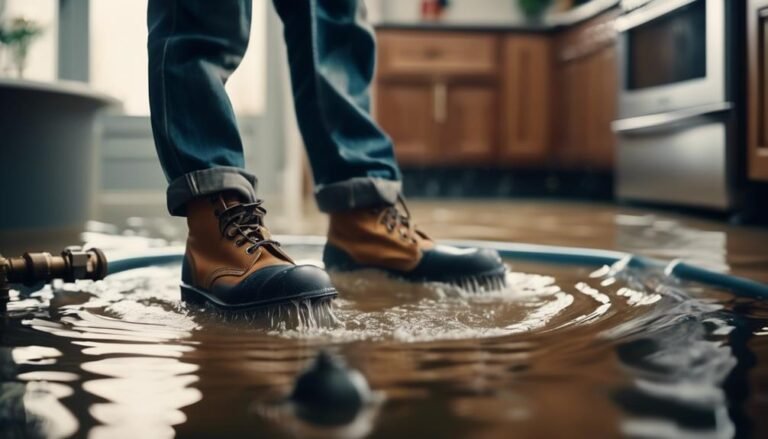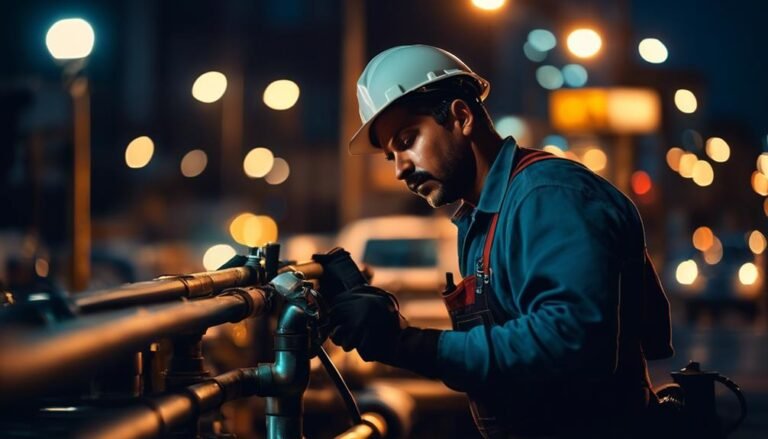11 Budget-Friendly Pipe Installation Tips for Antonio Homes
Tired of expensive pipe installation projects in your Antonio home? Imagine saving money while still achieving a successful plumbing upgrade. With 11 budget-friendly pipe installation tips, you can take control of your home improvement projects without sacrificing quality.
From choosing the right materials to improving water pressure, these tips will empower you to make informed decisions within your budget. But how can you achieve this?
If you're a homeowner looking to save money on pipe installation, these tips will help you make smart choices. By selecting affordable materials and optimizing water pressure, you can upgrade your plumbing without breaking the bank. It's important to make informed decisions and stay within your budget, and these tips will show you how.
Key Takeaways
Are you tired of costly pipe installation projects in your Antonio home? Imagine saving money while still achieving a successful plumbing upgrade. With 11 budget-friendly pipe installation tips, you can take control of your home improvement projects without sacrificing quality.
Choosing the right materials and improving water pressure are important steps in saving money on pipe installation. By making informed decisions and staying within your budget, you can upgrade your plumbing without breaking the bank. These tips will empower you to make smart choices and achieve your home improvement goals.
If you're a homeowner looking to save money on pipe installation, these tips will help you make informed decisions. Selecting affordable materials and optimizing water pressure are key factors in upgrading your plumbing within your budget. Let's explore how you can achieve this and make the most of your home improvement projects.
Assessing Your Plumbing Needs
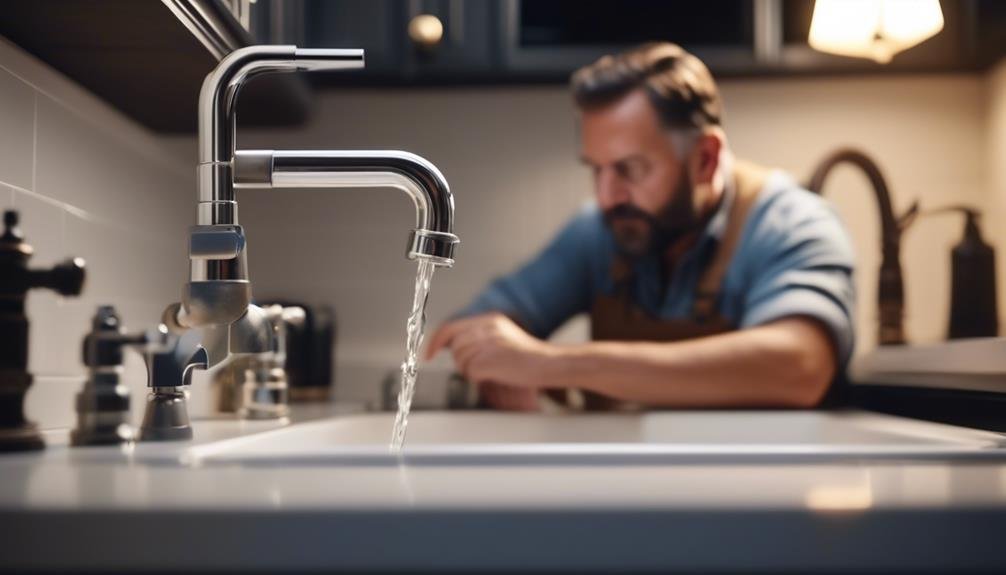
Assessing your plumbing needs is crucial for your home. Think about where you need shut-off valves for convenience and emergencies. Consider both current and future needs to avoid costly changes later on.
Don't forget about outdoor plumbing for things like irrigation systems and outdoor kitchens. In the kitchen, think about the plumbing for appliances and water supply. And for bathrooms, plan the plumbing lines based on fixtures, water pressure, and drainage needs.
Choosing the Right Pipe Material
Choosing the right pipe material for your home is an important decision. There are various options available, and it's essential to consider the durability and lifespan of each material to make sure it meets your specific plumbing needs.
Understanding the advantages and limitations of each material will help you make an informed decision for your pipe installation project.
Material Options
Looking for a strong, rust-resistant pipe material that works for hot and cold water in San Antonio? Check out these options:
- Copper: Resists rust and handles extreme temps.
- PVC: Affordable, tough, and great for cold water with a long lifespan.
- CPVC: Handles heat, good for hot and cold water, and has extra chlorine for safer drinking.
- PEX: Tough, budget-friendly, and resists rust, perfect for indoor plumbing.
- ABS: Stronger than PVC, can take freezing temps, and commonly used in homes, but keep it out of the sun.
Each one has its perks, so pick the best fit for your needs.
Durability and Lifespan
Choosing the right pipe material is crucial for your plumbing system's longevity and reliability. Different pipe materials like copper, PVC, and PEX pipes stand out when it comes to durability and lifespan.
Copper pipes are known for their long-lasting durability and can last up to 70 years, making them a popular choice for many homeowners.
PVC pipes are also durable and have a lifespan of 100 years, offering corrosion resistance and low maintenance.
PEX pipes are flexible and resistant to extreme temperatures, with a lifespan of around 40-50 years.
It's important to weigh factors like cost, maintenance, and potential for leaks or damage when considering the pros and cons of each material for your plumbing needs.
Understanding Pipe Sizing
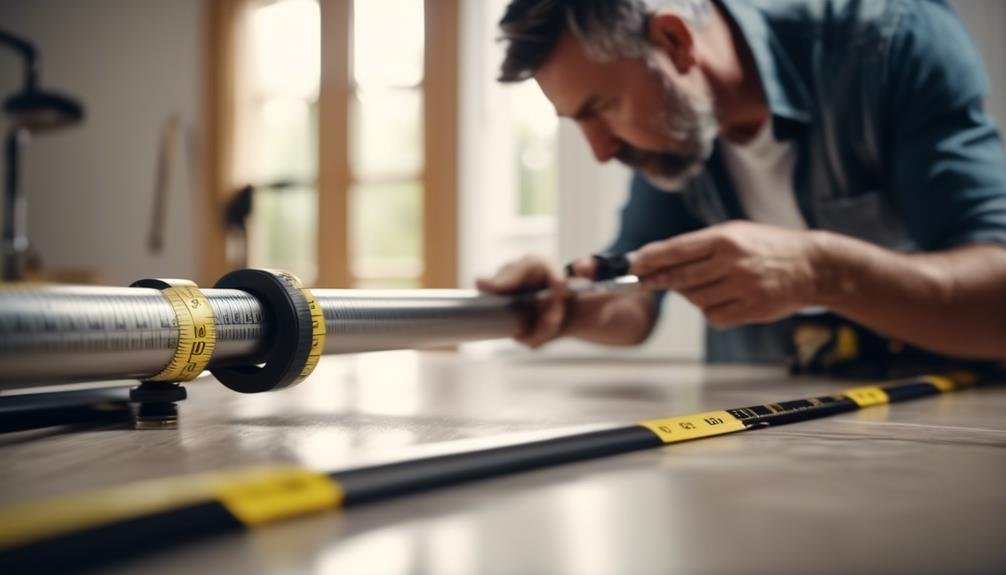
Understanding the right pipe size is crucial for ensuring your home's plumbing system works smoothly. There are a few things to keep in mind when it comes to pipe sizing:
- The number of fixtures in your home and how far they're from the water heater affect pipe sizing.
- Having the right pipe size is important for maintaining good water pressure and flow in your home.
- Sizing charts and calculations based on fixture units and pipe lengths are used to figure out the right pipe size.
- It's a good idea to consult a professional plumber to make sure the pipes in your home are the right size for your specific needs.
- Following local building codes is important when deciding on the size of your pipes.
Understanding pipe sizing is crucial for avoiding issues like low water pressure and making sure the right types of plumbing pipes are used in your home. Plus, getting the pipe size right is key for making sure your plumbing system works efficiently.
Properly Insulating Your Pipes
Properly insulating your pipes is crucial for keeping your plumbing system working smoothly and efficiently, especially during cold weather when freezing can be a problem. When it comes to taking care of your home, keeping your pipes insulated is a key part of preventing issues with your water supply.
To make sure your pipes are properly insulated, you can use insulation sleeves or wrapping to cover any exposed pipes in areas that don't get heated. It's also important to insulate all hot water pipes to save energy and prevent heat loss. You can use foam or fiberglass pipe insulation, which are both effective and affordable options.
Remember to check your pipe insulation regularly and replace any damaged or worn-out parts to keep it working well. By taking these steps, you can avoid the inconvenience and potential damage that come with frozen or burst pipes.
Properly insulating your pipes not only keeps your plumbing system reliable but also helps you save on energy costs. Including these insulation practices in your home maintenance routine will help keep your water supply system functional and efficient.
DIY Vs. Professional Installation
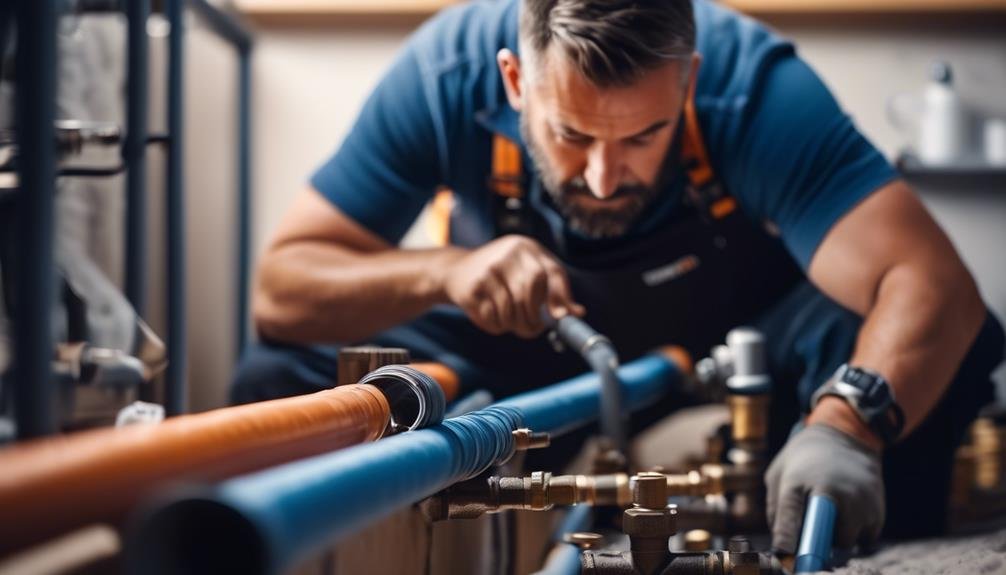
Consider the complexity and size of your plumbing project before deciding whether to tackle it yourself or hire a professional. Here are some things to think about:
- Simple Projects: If it's just a small repair or a basic installation, you might be able to handle it on your own and save some money.
- Complex Projects: For bigger jobs like new construction or major renovations, it's best to get a professional to make sure everything meets the rules and is done well.
- Your Skills and Tools: Think about what you know how to do and what tools you have before deciding if you can handle the job yourself.
- Budget: Compare the costs of doing it yourself versus hiring a pro, and think about any long-term savings or peace of mind that might come with getting it done professionally.
- Pipe Types: Some pipes and fittings need special knowledge and tools, so that might affect your decision about doing it yourself or getting a professional.
Thinking about these things will help you figure out the best way to approach your plumbing project.
Whether you decide to do it yourself or hire someone, making sure your home's water supply and plumbing system are in good shape is really important for any home improvements.
Utilizing Cost-Effective Pipe Fittings
When it comes to your plumbing system, it's important to find affordable and durable options. Consider using materials like PVC, PEX, CPVC, and ABS for your pipe fittings. These options aren't only cost-effective but also known for their resilience, making them suitable for various applications in your water supply system.
PVC and PEX pipes are excellent choices if you're looking to save money, as they're budget-friendly and strong. CPVC and ABS pipes are also practical options, known for their easy installation and flexibility, which can help you save on costs.
By choosing these cost-effective pipe fittings, you can manage your plumbing expenses without sacrificing performance. Compared to traditional materials like galvanized pipes, these options provide an economical solution.
Incorporating PVC, PEX, CPVC, and ABS pipes into your plumbing system is a smart and budget-friendly choice for homeowners.
Minimizing Wastage With Efficient Layout

When planning the layout for your plumbing, it's important to prioritize using the shortest and most direct pipe runs. This helps to minimize the amount of materials needed and reduces labor costs. By creating an efficient layout, you can minimize wastage and save on resources.
One way to achieve an efficient layout is to centralize the plumbing locations. This reduces the length of pipe runs and the number of fittings required. You can also use advanced piping design software to optimize the layout and minimize material wastage.
Another tip is to use standard pipe lengths and fittings effectively to reduce offcuts and waste. You may also want to consider using modular plumbing systems to minimize the need for custom or excessive pipe cutting and bending.
Considerations for Outdoor Pipe Installation
When you're planning to install pipes outdoors, it's important to use materials that can withstand the weather. This will help ensure that the pipes last a long time and don't get damaged easily.
It's also crucial to plan for proper drainage so that water doesn't build up and cause problems for your outdoor plumbing system.
Take the necessary precautions to protect your outdoor pipes from the elements and any potential hazards.
Weatherproof Materials
When installing pipes outdoors, it's important to use weatherproof materials like PVC or CPVC. These materials are durable and resistant to UV rays, corrosion, and freezing temperatures, which helps prevent deterioration and leaks.
Make sure to insulate the outdoor pipes properly to protect them from extreme weather and freezing. It's also a good idea to regularly check and maintain the outdoor pipes to keep them weatherproof and working well over time.
Another option to consider is ABS (Acrylonitrile Butadiene Styrene) pipes, which are also resistant to the elements. When installing outdoor pipes, it's crucial to consider water pressure, and using weatherproof materials will ensure the pipes can handle pressure changes and environmental factors.
Proper Drainage Planning
When you're planning the drainage for outdoor pipe installation, it's important to choose weatherproof materials like PVC or CPVC. These materials are tough and can handle freezing temperatures, UV rays, and corrosion.
When you lay out the outdoor drain lines, think about the slope and elevation. This helps the water flow properly and stops it from pooling up. Check the soil and ground conditions too, to make sure the pipes won't sink or get damaged.
And don't forget to add ventilation and access points for easy maintenance and repairs. It's vital to protect outdoor pipes from freezing and the elements to keep your water supply and drainage system in good shape.
Safety Precautions
When you're setting up outdoor pipes for your water supply, it's important to keep safety in mind to protect against hazards and make sure your plumbing lasts. Here are some things to think about:
- Make sure the pipes are properly grounded and insulated to avoid electrical problems and extreme weather.
- Use materials that can handle the weather and bury the pipes to protect them from damage and temperature changes.
- Take steps to stop the pipes from freezing and thawing, like adding insulation and heat tape.
- Secure the pipes to prevent damage from the soil moving, strong winds, or other things in the environment.
- Install devices to stop backflow and keep your water clean.
Following these safety measures will help keep your outdoor plumbing safe and make sure you have a steady water supply for your home.
Maintaining Water Pressure
As a homeowner, it's crucial to keep an eye on your plumbing system to ensure consistent water pressure. Start by regularly checking for leaks and blockages in your visible pipes. If you notice a decrease in water pressure, it could be a sign of an issue that needs attention.
Make sure all shut-off valves are fully open to allow maximum water flow to your fixtures. It's also important to clean faucets, showerheads, and aerators regularly to prevent mineral buildup that can restrict water flow.
Monitoring the water pressure gauge on the main line is also essential. Sudden drops in pressure could indicate a problem that needs to be addressed promptly. If the pressure is consistently too high, consider installing a water pressure regulator to protect your plumbing system and appliances.
Maintaining water pressure is key to ensuring a reliable water supply in your home's plumbing system, especially when using PVC pipes. By taking these measures, you can effectively preserve the water pressure in your home.
Extending Pipe Lifespan
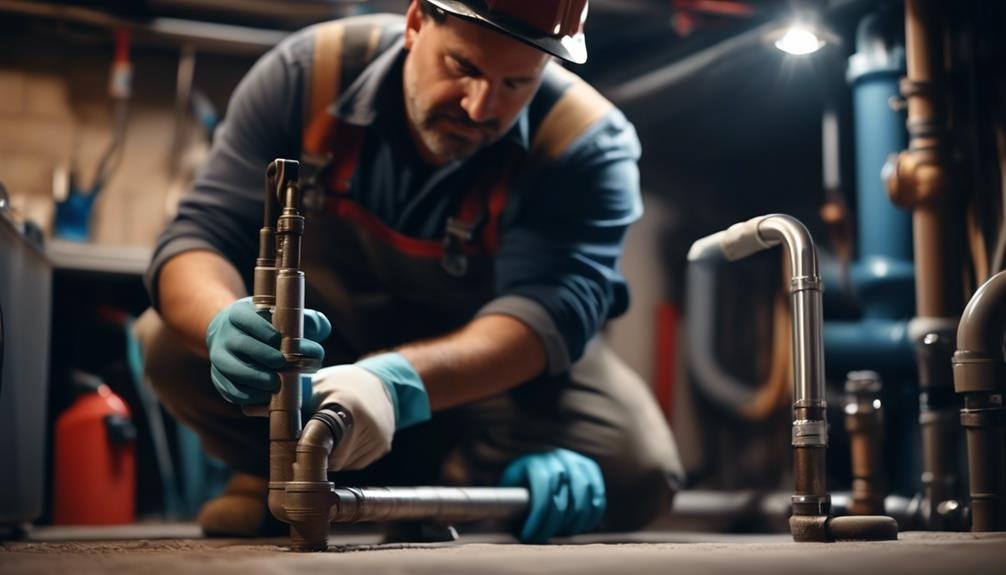
To keep your pipes in good shape for longer, you need to make smart choices about the materials you use and stay on top of regular maintenance.
Start by picking the right pipes for your water quality and needs. This helps prevent early rust and wear.
Plan for regular check-ups to catch and fix any issues before they get worse. This can help your pipes last longer.
Keep an eye on your water heaters, too. Look out for rust, leaks, or lower efficiency, as these can affect your pipes.
It's also a good idea to get advice from experienced plumbers. They can make sure your plumbing is installed and looked after properly, which might save you from needing emergency help later on.
And if your water quality isn't great, think about using filters or treatments. This can shield your pipes from potential harm.
Budget-Friendly Pipe Maintenance
Regularly inspecting and maintaining your pipes is essential for homeowners. By doing so, you can catch issues early and avoid expensive repairs down the line.
Applying simple do-it-yourself solutions like using pipe sealant or insulation can help prevent leaks and save on energy costs.
When it comes to new installations or replacements, consider opting for budget-friendly materials such as PVC or PEX pipes to keep maintenance expenses low.
This proactive approach to pipe maintenance can ultimately save you time and money in the long run.
Cost-Effective Maintenance Techniques
Maintaining your pipes on a budget is essential for homeowners. Consider using durable and affordable pipe options like PEX for your indoor plumbing needs. Here are some practical maintenance tips to help you keep your pipes in great condition:
- Check regularly for leaks and corrosion to catch problems early.
- Use drain strainers to prevent clogs and reduce the need for expensive repairs.
- Insulate exposed pipes to protect them from freezing and potential bursting.
- Think about getting a water softener to reduce mineral buildup and prolong the life of your pipes.
- Learn about DIY pipe maintenance tasks, like fixing minor leaks and unclogging drains, to save on professional service fees.
DIY Pipe Repair Methods
Looking after your pipes on a budget? DIY pipe repair methods can help you fix minor leaks and cracks without breaking the bank, ensuring your plumbing system stays in good shape. Here are some practical tips for DIY pipe repair:
- Insulate your pipes to prevent freezing and bursting in cold weather.
- Regularly check for leaks and corrosion to catch issues early.
- Use DIY pipe repair kits to fix minor leaks and cracks.
- Think about installing water pressure regulators to prevent pipe damage.
- Keep an eye on water usage to spot potential pipe issues.
Taking care of your pipes with these DIY methods can save you money and keep your plumbing system running smoothly.
Affordable Plumbing Solutions
Are you looking for budget-friendly ways to maintain your home's plumbing system? Here are some affordable plumbing solutions that can help you save money while keeping your pipes in good shape:
- Make sure to regularly check and maintain your plumbing pipes to catch any leaks or issues early on.
- Consider using cost-effective and durable pipe options like PVC, CPVC, and PEX for any new plumbing installations in your home.
- Installing shut-off valves in strategic locations can make future maintenance and repairs much easier.
- Plan ahead for your current and future plumbing needs, whether it's for your kitchen, bathroom, or outdoor plumbing.
When it comes to professional plumbing installation services, consider hiring a licensed and reputable company like Christianson Air Conditioning Plumbing Services.
Frequently Asked Questions
What Is the Most Expensive Water Pipe Material to Install?
Copper pipes are the priciest water pipe material to set up in your home. This is because they are very durable, resistant to rust, and can handle extreme temperatures. With a lifespan of about 50 years, they are a solid long-term investment for your home's plumbing system.
How Do I Prepare My House for Repiping?
Getting your house ready for repiping involves assessing your current and future plumbing needs. It's important to make sure that the shut-off valves are easily accessible and to plan for the plumbing in your kitchen, bathrooms, and outdoor areas. Don't overlook the specific plumbing lines for your laundry room. By evaluating these factors, you can ensure that your house is well-prepared for the repiping process.
What Type of Pipe Is Easiest to Install?
PEX pipes are the easiest to install because they are flexible and color-coded for hot and cold water. This makes it simple for homeowners to connect them to a water distribution manifold, saving time and effort during installation. Plus, the flexibility of PEX pipes allows for easier maneuvering around obstacles, making the whole process even more convenient for you.
Should I Use 1 2 or 3 4 PEX for My House?
Consider using 1/2 PEX for smaller water lines and fixtures, or 3/4 PEX for larger water lines and higher water flow. It's important to evaluate your home's water pressure and flow rates. Consulting a plumber can help you make an informed decision.

